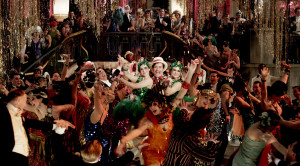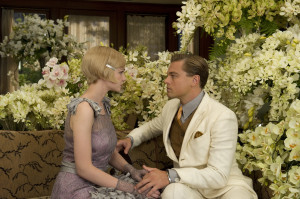
From the moment “The Great Gatsby” starts, it is clear that this is Baz Luhrmann’s Gatsby, not F. Scott Fitzgerald’s. While the movie is a pretty faithful word-by-word adaption of “The Great Gatsby,” it lacks the spirit of its original source. In the novel, the images Fitzgerald conjures are beautiful simply because they are there. It’s also a relatively short and compact novel filled with subtleties you only notice on rereads. In the movie, not only must Fitzgerald’s best descriptions be depicted with heavy amounts of gaudy CGI, but sometimes the words even need to be plastered on screen. The movie really tries too hard to convey the messages and meaning of “The Great Gatsby.” Everything is too obvious, overstated, and overdramatic. Even for the Roaring Twenties, there is a little too much glitter and sparkling baubles for viewers to take seriously.
In “The Great Gatsby,” we follow Nick Carraway (Tobey Maguire) as he recalls and recovers from his recent experience with the decadence of New York. Nick is disgusted by everyone he met in New York–except for the mysterious Jay Gatsby, a newly wealthy man who throws giant, crazy parties in his castle-like mansion (Leonardo DiCaprio). The movie starts off shaky with Maguire trying too hard in his narration to show that he is world-weary and cynical. Unfortunately, as the movie progresses, it is clear that Maguire is probably the least guilty of overacting among the usually talented cast. Leonardo DiCaprio as Jay Gatsby is not very memorable, except for how he seems to look unusually shiny and airbrushed compared to everyone else. Carey Mulligan’s Daisy Buchanan comes off as oddly sympathetic, mainly because Daisy is too superficial to know any better. The rest of the main cast is rounded out by: Joel Edgerton as Tom Buchanan; Elizabeth Debicki as Jordan Baker; and Isla Fischer as Myrtle Wilson.

There’s one scene early on that captures everything wrong with the movie. Gatsby’s smile is famously described to be one of those rare smiles that have “a quality of eternal reassurance.” When Nick meets Gatsby for the very first time, not only does the music swell and Gatsby seem to glow via CGI magic, but a slew of fireworks also happen to explode in the background. There are several moments like this in the movie that made me wonder if I was watching a strange version of “Alice in Wonderland: the Flapper Edition” instead.
I expected that the use of modern music, including Jay-Z rap instead of jazz during the characters’ celebrations, would be off-putting. Surprisingly, this was not the case; I found the soundtrack to actually be one of the better aspects of a deeply flawed film.
“The Great Gatsby” is filled with complicated visuals, but unfortunately, like the bottles of champagne and confetti that the characters open, the movie is light on actual substance.